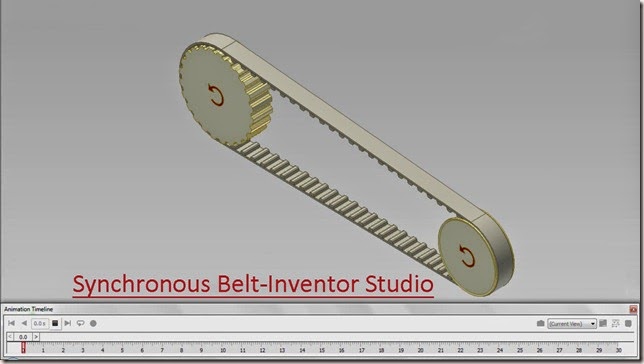Serial No. 94
Synchronous Belt-Inventor Studio-Autodesk Inventor 2012 (with caption and audio narration)
In this video, we will demonstrate how to apply the different type of mates in the assembly environment for creating the animation of the ‘Synchronous Belt’.
Click the following link to get the model file: - http://bit.ly/2mC9Z3Z
Transcription of Video
Display of motion in ‘Synchronous Belt-Inventor Studio’ through Inventor Studio
- Create a New ‘Standard (mm) .ipt’ Part file.
- At present Sketch1 is active by default.
- Use the Finish Sketch command to exit from sketching mode.
- Open the visibility of YZ Work Plane under the origin folder in the Browser Bar.
- Create a new Work Plane Parallel to YZ Plane at an offset distance of 323.623 mm.
- Create a new Sketch on XY Plane.
- Draw a Circle of 97.021 mm diameter, coincident with the auto projected part origin.
- Create another Circle of 72.766 mm diameter. The distance between these two circles is 323.623 mm.
- Take the project of X Axis and convert it to construction geometry.
- The centre of small circle is 12.128 mm below the projected X Axis line.
- Draw a line connecting top of two circles as displayed.
- Take the project of YZ Plane and convert it to construction geometry.
- Draw another line between two circles.
- Erase the unwanted sketches by using the Trim tool.
- Apply dimensions to fully constraint the sketch as displayed.
- Take the project of Work Plane1 from the browser bar, with use of Project Geometry tool.
- Convert this line into construction geometry.
- Apply a dimension between these two projected lines. This dimension is driven dimension.
- Now the sketch is complete, exit the sketch environment.
- Create a Work Point at the intersection of YZ Plane and bottom line of the sketch.
- Activate the Parameters tool from the Parameters Panel of the Manage tab.
- Create a User defined Parameter named ‘start’ by clicking ‘Add Numeric’ button in the Parameters dialog box.
- Click the ‘Equation’ column and then select the driven dimension in the design window.
- Click Done.
- Save the Part file with the name ‘Locus of Tooth’.
- Start the Rectangular Pattern Tool and select Work Point1 in the Browser Bar as feature.
- Click the ‘Direction 1’ button and select the sketch in the design window.
- In the Column spacing input box, click arrow button to expand choices.
- Select List Parameters then select the ‘start’.
- Click more button to expand the dialogue box.
- Select Adjust in the ‘Compute’ option.
- Click the Start button in the ‘Direction 1’ field and select the Work Point1 in the Browser Bar.
- Click OK.
- Open the visibility of Sketch2 from the Browser Bar.
- Select Work Plane1 in the Browser Bar and make it ‘Adaptive’ from the context menu.
- Activate Rectangular Pattern Tool once again.
- Select Work Point2 in the Browser Bar as feature.
- Click the ‘Direction 1’ button and select the sketch in the design window.
- In the Column Count input box, enter the value 72.
- Click this drop down to specify pattern length.
- Select ‘Curve Length’ option.
- Click the more button to expand the dialogue box.
- Select Adjust in the ‘Compute’ option.
- Click the Start button in the ‘Direction 1’ field and select the Work Point2.
- Select Direction1 in the ‘Orientation’ option.
- Click OK.
- Save the file and close it.
- Create a ‘‘Standard (mm) .iam’ assembly’ and save it with the name ‘Synchronous Belt -Inventor Studio’.
- Select ‘Place component’ tool from the marking menu and place the ‘Locus of Tooth’ Part in the Assembly.
- Select the ‘Locus of Tooth’ Sketch from the Browser Bar, right click and deselect Grounded from the context menu.
- Select the ‘Locus of Tooth’ Sketch again and make it ‘Adaptive’ from the context menu.
- Align the model in appropriate position using the View Cube.
- Apply a Flush Mate between YZ Plane of Assembly and YZ Plane of Locus of Tooth.
- Apply a Flush Mate between XZ Plane of Assembly and XZ Plane of Locus of Tooth.
- Apply a Flush Mate between XY Plane of Assembly and XY Plane of Locus of Tooth.
- Apply a Mate Constraint between YZ Plane of Assembly and Work Plane1 of Locus of Tooth.
- Inter the value 323.623 mm in the Offset input box.
- Click OK.
- Select ‘Place component’ tool from the marking menu and place the ‘Tooth’ part in the Assembly.
- Set the browser from Assembly View to Modeling View using the toggle at the top of the browser.
- Apply a Mate Constraint between Work Point2 of ‘Tooth’ and Work Point2 of ‘Locus of Tooth’.
- Change the view of design window by using View Cube.
- Apply a Flush Mate between XY Plane of Assembly and XY Plane of ‘Tooth’.
- Apply an Angle Constraint between XZ Plane of Assembly and XZ Plane of ‘Tooth’.
- Select Directed Angle option in the solution field.
- Close the visibility of Work Planes, visible in the design window.
- Create a Work Axis in the Assembly on this point, parallel to Z Axis of the Assembly.
- Place the ‘Belt-Base’ in the Assembly.
- Apply a Mate Constraint between Z Axis of Assembly and Z Axis of Belt-Base.
- Apply an Axis Mate between Belt-Base and Work Axis1 of Assembly.
- Apply a Mate Constraint between XY Plane of Assembly and XY Plane of Belt-Base.
- Start the Pattern Component Tool from the Component Panel of Assemble tab.
- Select the ‘Tooth’ as component, then select Rectangular Pattern2 of Locus of Tooth in the Browser Bar as Associative Feature Pattern.
- Click OK.
- Now all the ‘Teeth’ are fitted on the Locus of Teeth.
- Select ‘Place component’ from the marking menu and place the ‘Small Pulley’ in the Assembly.
- Apply a Mate Constraint between Z Axis of ‘Small Pulley’ and Work Axis1 of the Assembly.
- Apply a Mate Constraint between XY Plane of ‘Small Pulley’ and XY Plane of the Assembly.
- Select ‘Place component’ from the marking menu and place the ‘Large Pulley’ in the Assembly.
- Apply a Mate Constraint between Z Axis of ‘Large Pulley’ and Z Axis of the Assembly.
- Apply a Mate Constraint between XY Plane of Assembly and XY Plane of the ‘Large Pulley’.
- Change the view of design window by using View Cube.
- Activate Motion Constraint Command, first select Z Axis of ‘Large Pulley’ and then select Z Axis of ‘Small- Pulley’. Click OK.
- Apply an Angle Constraint between XZ Plane of Assembly and XZ Plane of ‘Small Pulley’.
- Select Directed Angle option in the solution field.
- Change the name of Mate:1 constraint to ‘Drive-1’, and Angle:3 constraint to ‘Drive-2’ in the Browser Bar.
- Click the ‘Inventor Studio’ icon from the Begin Panel of Environments Tab.
- Select Drive-1 Constraint of Locus of Tooth in the Browser Bar, right click and select Animate Constraints in the context menu.
- In the ‘Time’ section of Animate Constraint dialogue box, enter the value 30 second in the End input box.
- In ‘Action’ section, enter the value 1 mm in the End input box.
- Click Acceleration Tab.
- Select Constant Speed radio button in the Velocity Profile.
- Click OK.
- Select Expand Action Editor Button on the Animation Timeline.
- Select Drive-2 Angle Constraint of Small-Pulley in the Browser Bar, right click and select Animate Constraints in the context menu.
- In the ‘Action’ section of Animate Constraint dialogue box, enter the value (-360 degree) in the End input box.
- In the ‘Time’ section, click the Specify Start Time button.
- Click Acceleration Tab.
- Select Constant Speed radio button in the Velocity Profile.
- Click OK.
- Select Collapse Action Editor Button on the Animation Timeline.
- Click the Animation Options Button.
- In the Animation Options dialogue box, select Constant Speed radio button in the Default Velocity Profile.
- Click Ok.
- Close the visibility of all the Sketches and Work features.
- Clear the screen by activating the Clean Screen command.
- Click ‘Go to Start’ Button.
- Click Play Animation button.



No comments:
Post a Comment